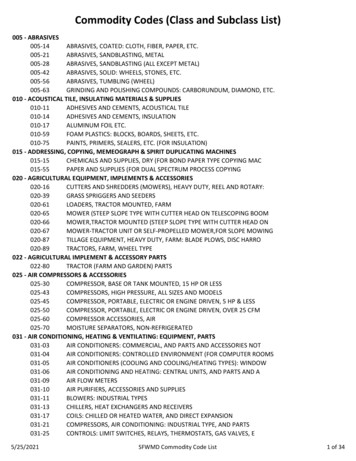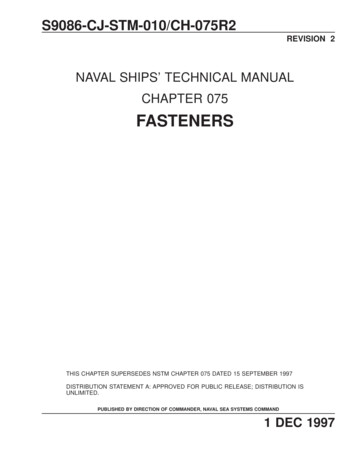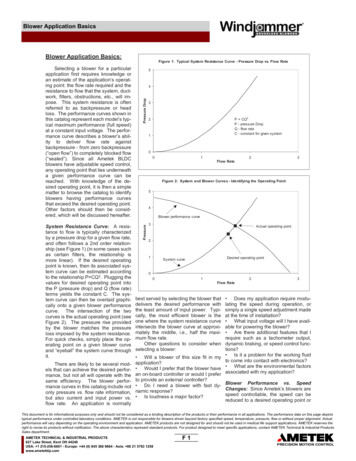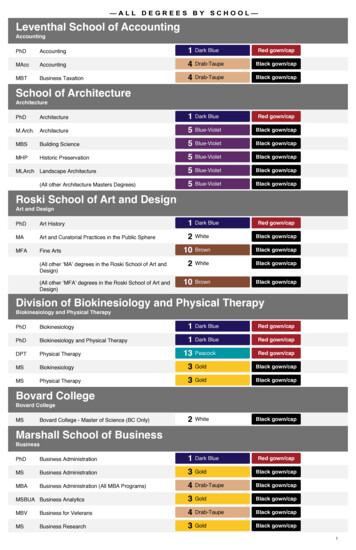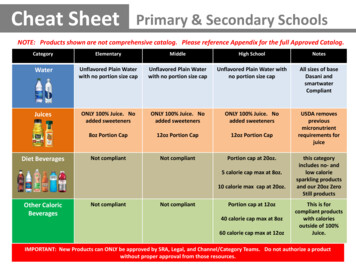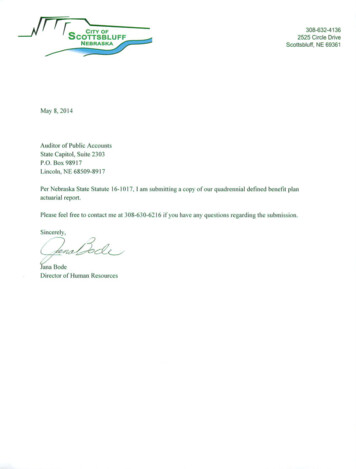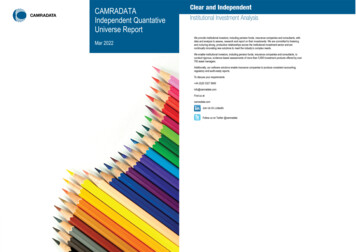
Transcription
TEN-16-075. PRICE CAP RESEARCHTechnical ReportPrepared for:Financial Conduct Authority25 The North ColonnadeCanary wharfLondon E1416 June 2017
Table of ContentsAcknowledgements . 2The Authors . 3Glossary . 41. Introduction . 61.1 Research background . 61.2 Questionnaire length. 61.3 Fieldwork dates . 62. Sample Design . 72.1 Database development . 72.2 Summary of exclusions from the sampling stage. 92.3 Population building . 92.4 Sub-population groups . 93. Questionnaire Development . 143.1 Measuring use of illegal money lenders. 143.2 Questionnaire programming . 153.3 Quality control processes . 154. Pilot . 164.1 Outcomes . 164.2 Pilot recommendations including questionnaire changes . 164.3 Encouraging response . 175. Fieldwork . 185.1 Interviewer briefing . 185.2 Location of telephone centres . 185.3 Hotline and forewarning letter . 195.4 Supervision and quality control. 195.5 Incentivisation . 196. Data processing . 206.1 Recoding . 206.2 Statistical tabulations . 206.3 Significance testing . 207. Sample representation . 217.1 Comparison of interviewed sample versus the population . 227.2 Sample outcomes . 238. Weighting . 258.1 Weighting variables . 258.2 Weighting efficiency . 27Appendix 1: data request to firms. 281
AcknowledgementsWe would like to thank the Financial Conduct Authority (FCA) for supporting this piece of research.Leslie Sopp and Simon Sarkar have been responsible for managing this project at the FCA and haveboth provided excellent design support and guidance from the first instance.We would also like to thank those staff within the consumer credit policy team for their specialistproduct knowledge and willingness to assist throughout the process, in particular Benedict GuttmanKenney and David Mendes Da Costa whose thoughtful inputs guided the reporting process.There have been many other contributions to the project from within the FCA, in particular shapingthe content of both the technical report and the main findings report, and we are grateful for all thehelpful comments and guidance received.Finally, we would like to thank all the individuals who gave their time generously to participate in thisresearch.2
The AuthorsJames Hopkins, Research Director at Critical Research heads the company’s public sector and financialresearch departments, having worked in market research for nearly 20 years. A life sciences degreefrom Manchester University stimulated a career in project management, analysis and statistics; Jameshas directed several high profile projects in pensions, financial intermediation, regulation andconsumer credit research. He has presented findings for the FCA at the Market Research Summit, andspoken on financial research to app party steering groups at the House of Commons.Steve Pick, Research Director at Critical Research specialises in financial research working fororganisations such as the Pensions and Lifetime Savings Association (previously NAPF) and theChartered Insurance Institute. His degree in Applied Multimedia has led him to some of the moretechnical and high profile studies, such as his recent work mapping trust in the financial servicesindustry. Steve has over 10 years’ experience in running large sample size telephone research.Derek Farr, Statistical Consultant, is a qualified statistician and has almost 40 years of researchexperience. Having established the UK’s first specialised computerised telephone research company inthe late 1970s, he is well-known in the industry, and has presented a number of papers at the RoyalStatistical Society, the Market Research Society and marketing forums. Derek specialises in the designof sampling regimes and the impact of sample design and research methodology on the estimation ofsurvey statistics.3
GlossaryConsumer credits termsFCAFinancial Conduct AuthorityHCSTCHigh Cost Short Term Credit, defined in the FCA handbook 1Illegal money lendingLending that is not regulated by the FCA conducted in a way to earnmoney from lendingPrice capThe general term used to cover the price restrictions the FCA introducedto HCSTC in January 2015Payday loanThe term used for survey participants to describe HCSTCResearch termsConfidence interval (CI)The range within which a survey statistic falls 95% of the time, based oninterviewing a sample of consumers.Sample GroupLenders were asked to make 2 selections of customers, to reflect thoseactive customers (A. applied for a payday loan) and those who haveformer (B. used to, but have not recently taken out a payday loan)GroupsActive customers were divided into 3 groups:1. Accepted for a PDL (accepted)2. Declined a PDL (declined)3. Previously had PDLs but have stopped applying (former)This status was checked during the interview, and only those who agreed14See Annex 4 for the full definition
with the sample information were classified into these 3 groups in theanalysis stage.5
1.IntroductionThis report summarises the methodological approach used for the Price Cap Research undertaken in2017. For further information and findings from this research, please visit www.fca.org.uk.1.1 Research backgroundPrior to September 2014, providers of High Cost Short Term Credit (HCSTC) were not regulated by theFCA and were instead covered by regulations stipulated by the OFT under the Consumer Credit Act.Largely these firms were those previously known as Payday Lenders: that is firms offering very shortterm loans with a high interest rate as a stop gap for consumers until payday.When the FCA took over regulation of consumer credit firms, including HCSTC providers, a greaterdegree of regulation was introduced in order to reduce customer detriment whilst providing suitablechoice for consumers, in a competitive market. Due to the short-term nature of HCSTC, a furtherregulation was introduced for lenders providing loans with an APR in excess of 100% to ensureborrowers were not charged excessively.The “Price Cap” regulation, introduced in January 2015, ensured a limit to the amount of fees andinterest a consumer would pay, in particular if they were unable to meet repayments. Consumerscannot be charged more than 100% of the original loan value in fees and interest; there is a 15 cap ondefault fees; and, an initial cap of 0.8% interest per day cannot be exceeded.Whilst these measures are designed to protect consumers from high charges, it does mean that morepeople may become ineligible for loans of this nature. Potentially a large number of consumerstherefore might seek loans elsewhere, possibly even extending to illegal money lenders. For thisreason, and to check for other unforeseen consequences, the FCA committed to conducting consumerresearch to establish the impact of the price cap.1.2 Questionnaire lengthThe questionnaire took on average 25 minutes to complete, although the range varied from 19 to 34minutes. Overall there were approximately 30 minutes of questions available, but due to routing, noteveryone was eligible to be asked all questions.Interviews which lasted longer than average were typically those where the respondent was able toprovide longer answers to some of the open-ended questions.1.3 Fieldwork datesTelephone fieldwork ran continuously over a 12-week period, starting on 23 January 2017 and wascompleted on 21 April 2017.6
2.Sample DesignIn order to produce a reasonable sample frame, 8 HCSTC lenders were asked to provide extracts fromtheir customer base. Lenders were asked to provide customers in two groups:Group A, Recent Applicants. Those applying for a HCSTC loan between 01 May 2016 and 31 October2016, regardless of the outcome of that application.Group B, Former Borrowers. Those successfully applying for a HCSTC loan between 01 January 2014and 30 April 2016, who have not applied for a loan since then.All firms provided their submissions by Friday 16 December 2016. The data request to lenders made bythe FCA using its legal powers is available in Appendix 1: data request to firms.2.1 Database developmentIn order to approximate the population of payday loan customers, a database comprising thesubmissions from all 8 lenders was created. Each lender provided 10,500 customers 2 split into Group A(7,000 customers) and Group B (3,500 customers).When processing the data some anomalies were found for Group A as follows Last loan acceptance date was prior to 01 May 2016Last loan acceptance date was blankLast loan acceptance date was blank and last loan rejection date was blankLast loan rejection date was before last loan application dateLast loan value was 0Some lenders provided additional explanations for some of these scenarios, which enabled decisionsabout whether to exclude such customers from the sample:It may happen that the customer's application was approved however, the customer did not signthe contract. In these cases, this column will remain null. This may result in scenarios, where thevariable numberLoanApplications is greater than numberLoanAcceptance (customer applied2With the exception of one lender who provided a second tranche of customers profiled in exactly the same way, towardsthe end of fieldwork to assist with achieving the final number of interviews.7
more times than we funded a loan); however, the lastLoanrejected 3 remains null (as allapplications may have been approved, but we did not fund a loan).In total 1334 Group A anomalies were excluded (2.4%).For Group B, similar anomalies were found: Last loan acceptance date was after October 2016Last loan application date was blankLast loan acceptance date was after April 2016Last loan acceptance date was blankLast loan value was 0In total 413 Group B anomalies were excluded (1.5%).All anomalies listed above were excluded from the sampling processes.2.1.1Deduplication and missing contact details2,483 records were excluded as a customer appeared multiple times across the database (andoccasionally within the records provided by each lender). A combination of name, mobile phonenumber, email address and postal address were used to removed subsequent records leaving adatabase of unique individuals.A further 1,298 customer records were excluded from the final sampling due to missing telephonenumbers that could not be sourced. Finally, 2 records were removed because the age and date of birthwere obviously wrong and could not be allocated to the sampling profile.38See Annex 3 for definitions of numberLoanApplications, numberLoanAcceptance and lastLoanrejected
2.2 Summary of exclusions from the sampling stageThe following table shows how the exclusions were applied.Group AGroup BTotalStarting number of customers560002800084000-Removed: anomalous13344131747-Removed: duplicated19115722483-Removed: wrong age112-Removed: total32469864232Total 70Removed: no phone numbersTotal sampleable populationTable 1. Sample breakdown showing exclusionsWith anomalies and duplicates removed, 79,768 records were put forward for some further profilingwork (see sections 2.3 and 2.4). However as some of these could not be contacted for the telephoneinterviews, 78,470 records were available for sampling.2.3 Population buildingFrom Table 1 above, 79,768 records were used to develop some statistics about the sub-populations.Results are shown below (but note, they are not weighted by lender).2.4 Sub-population groupsFrom the 2 sample groups, three populations were defined, as follows: Group 1. Consumers from Group A who applied for a payday loan 4 and were declined from May2016 onwards (and were not accepted for a payday loan after this date) Group 2. Consumers from Group A who applied for a payday loan and were accepted from May2016 onwards Group 3 – Consumers from Group B who used to use payday loans between January 2016 andApril 2016 but have not applied since May 2016.4The term ‘payday loan’ was used in the survey as consumers are more familiar with this term than ‘high cost short termcredit’. The sample is not restricted to only single instalment short term loans but also includes multiple instalment loans orany other loan captured under the definition of HCSTC.9
10
The groups have the following age and gender profiles:Group 1MaleFemaleTotal18 to 243747 (26%)3001 (26%)6748 (26%)25 to 345653 (40%)4386 (38%)10039 (39%)35 to 442679 (19%)2205 (19%)4884 (19%)45 to 541537 (11%)1467 (13%)3004 (12%)55 to 64540 (4%)497 (4%)1037 (4%)93 (1%)101 (1%)194 (1%)Total:142491165725906Mean age:32.433.032.7Group 2MaleFemaleTotal18 to 243314 (20%)2202 (21%)5516 (21%)25 to 346641 (41%)3905 (37%)10546 (39%)35 to 443563 (22%)2216 (21%)5779 (22%)45 to 542076 (13%)1581 (15%)3657 (14%)55 to 64656 (4%)516 (5%)1172 (4%)99 (1%)79 (1%)178 (1%)Total:163491049926848Mean age:33.834.434.0Group 3MaleFemaleTotal18 to 242466 (15%)1652 (15%)4118 (15%)25 to 346711 (42%)4287 (39%)10998 (41%)35 to 443675 (23%)2445 (22%)6120 (23%)45 to 542183 (14%)1836 (17%)4019 (15%)55 to 64840 (5%)686 (6%)1526 (6%)65 144 (1%)88 (1%)232 (1%)Total:160191099427013Mean age:34.935.835.365 Table 2. Group 1 age and gender profile65 Table 3. Group 2 age and gender profileTable 4. Group 3 age and gender profileThe profiles across all three groups are quite similar, indicating there are not many substantialdifferences in these demographics. Those which are thought to be former customers (Group 3), doappear to have a slightly older age profile however.11
Looking at average loan values by age and group:Average last loan valueGroup 2Group 3Total18 to 24 366 311 34225 to 34 448 382 41435 to 44 514 442 47745 to 54 546 464 50455 to 64 545 500 52065 464 464 464Male 472 416-Female 449 387- 463 404-Overall average:Table 5. Profile of average loan value by age and GroupGroup 1 values are not shown, as many customers allocated to Group 1 (declined) had not previouslyhad a payday loan value.12
Those in Group 3 (former) also consistently have borrowed less. This could be in part inflationary(Group 3 customers typically borrowed about a year before on average), but the figures differ by farmore than 3%.Average last loan valueGroup 2Group 3TotalLondon 519 462 493Offshore 486 481 482South East 488 427 458West Midlands 469 406 437Scotland 467 401 435East of England 456 406 430South West 460 388 424Northern Ireland 452 381 417Wales 433 394 412East Midlands 436 386 410North West 431 385 407Yorkshire & Humberside 438 375 407North East 438 373 405 463 404 434Overall average:Table 6. Profile of average loan value by region and GroupThe same differential by Group exists across each region. Furthermore, there are some differences inaverage loan values across the regions. Perhaps predictably, London and the South East appear in thetop 3 regions by average loan amount. Scotland is perhaps higher than expected, assuming typicalregional differences13
3.Questionnaire DevelopmentThe questionnaire was developed by the FCA research team, with input and consultation from CriticalResearch from the outset. Where appropriate some questions from relevant previous research wereused, including the previous research into Payday lending conducted by TNS-BMRB in 2014. 53.1 Measuring use of illegal money lendersWhilst many of the questions are standard and straightforward, one of the research objectives was totry to measure the extent to which illegal money lenders were being used, especially as a result ofbeing denied access to regulated lenders. Typically, when questioned directly, most people will notadmit to behaviour that may be considered reprehensible for fear of the consequences.For this research, two techniques were used to overcome this which are described below.3.1.1Item countThis is a method of counting the number of items or ‘behaviours’ that have been conducted withoutthe person having to specifically name the items. To implement this for the research, the sample wasspilt into 2 halves, the first half receiving a control list of 4 items and the second half receiving thesame list, together with a fifth item of “Used an illegal money lender”. Each respondent was thenasked to state how many of the items they had done in the last 12 months, without having to statewhich ones specifically they had done.For analysis, the two samples were matched demographically, and the differences in the mean numberof mentions between the two lists were compared. Theoretically the increased average number ofmentions in the second list, equates to use of illegal money lenders. There are some limitations to thistechnique, but it does help overcome the reluctance of some people to describe their behaviourdirectly to an interviewer. 2.pdf6Further papers about handling the item count technique.http://www.stat.columbia.edu/ demia.edu/1817890/The Item Count Method for Sensitive Survey Questions Modelling Criminal Behaviour; http://imai.princeton.edu/research/files/list.pdf; http://imai.princeton.edu/talk/files/UCI11.pdf.14
3.1.2Indirect questioningThroughout the questionnaire a number of open and part-open questions were used to establishwhich alternative options had been considered or used. Furthermore, two questions were includedwhich followed up on use of informal money lenders such as friends, family and other members of thecommunity. These questions established whether the informal lender charged interest, or lends as away of making money. Additional questions were asked about the possible outcomes of not paying.The pattern of responses at these questions can be used together to form an indication of whether anindividual is at risk of using illegal money lenders, without the need for asking the question directly.3.2 Questionnaire programmingOnce the questionnaire was agreed, the questions were scripted using specialist market researchsoftware (Askia). The system allowed for complex routing and question filtering to ensure the correctflow and path through the questionnaire, as well as text substitution where alternative wording wasrequired. The system also allocated at random one of the item count lists to each participant.Once computerised, the resulting script was checked against the agreed questionnaire to ensure thecorrect questions were being administered and in the order intended.3.3 Quality control processesThroughout the questionnaire scripting stage, each version of the script was logged and checkedagainst the questionnaire. In total, including the pilot, 10 versions of the questionnaire script wereproduced. Each time the following processes were undertaken: Questionnaire checks:-Question wording was appropriate-Correct routing was applied-Wording changes implemented, that may be necessary for different audiences-Changes did not disrupt the flow or have consequences elsewhere in the questionnaire Programmed script checks-Wording and routing matched the latest version questionnaire-Full version of the questionnaire checked for each sample group-Resulting test data was in correct format and as expected-Changes were compatible with any earlier data already collected15
4.PilotPilot work conducted from 13-25 January 2017. The objectives of the pilot were as follows: To test whether the questionnaire was working as intended, that questions were understoodand being answered as expected To establish questionnaire lengthTo test the sampling processes and to establish how best to sample for the main stageTo establish response rates and determined if any changes were required to the approach andscreening questions4.1 OutcomesIn total 30 interviews were achieved for the pilot. The total number of people contacted, and theiroutcomes at the end of the pilot were as follows:TotalGroup 1(Declined)Group 2(Accepted)Group 3(Former)Completed interviews3011127Failed screening questions3914916Refusals122414536Appointments to call back another time37711281184Voicemail left189638343Multiple no answer963294323346Ineffective telephone numbers390151811582110686634790Total:Table 7. Pilot outcomes for each customer recordThe outcomes of the pilot were also used to inform subsequent sampling processes.4.2 Pilot recommendations including questionnaire changesThe pilot enabled a number of minor changes to be made to improve the survey. Broadly speakingthese were questionnaire changes (largely removing questions) and changes to the screeningprocesses. Below is a summary of the changes to the approach as a result of the pilot: 16Screening questions were modified to add additional “prompt” style questions wherever therespondent’s answer appears to contradict lender records, specifically when:-The respondent claims not to have taken out a loan in the last 12 months (Question 1.1)-The respondent claims not to have been declined a loan in the last 12 months (Question1.3)
-The respondent was declined, but claims to have been accepted for a loan from anotherprovider (Question 1.4)-The respondent claims not to have had any payday loans since January 2014 (Question 1.6) The questionnaire sequence from 3.24 to 3.31 was changed and two questions were amendedto be entirely open-ended questions. Questionnaire length was reduced by removing or changing several questions.4.3 Encouraging responseFollowing learning from the pilot, two additional strategies were adopted which had a positive impacton strike rates: Wherever a landline or mobile voicemail was encountered a short voicemail was left as follows:“Sorry to bother you. This is James calling on behalf of the FCA. It is nothing to worryabout and not urgent. We would like to ask you a few questions about some financialservices you may use. We will try you another time.” Whilst the majority of calls were conducted between 5pm and 9pm, with some weekend calls,success was also had calling during working hours too. Mobiles were more likely to beanswered in the daytime and appointments then made for an evening interview.17
5.FieldworkAll interviews were conducted using Computer Assisted Telephone Interviewing and occurred in inJanuary to April 2017. The research was compliant with the Market Research Society Code ofConduct, 7 using a team of well-trained interviewers experienced in undertaking consumer interviewsabout money and finance.5.1 Interviewer briefingA team of 42 interviewers was used to complete the fieldwork. Each interviewer received a briefingfrom the Research Director which covered: The research background. This included the research sponsor and the objectives. Interviewerswere familiar with the FCA in particular the changing regulatory landscape in consumer credit,but nonetheless the team was brought up to speed on the Price Cap regulations and possibleconsequences of change. Terminology. As some terms that may not be familiar to all participants were being used, thesewere defined in a small glossary. Sampling and interviews. Interviewers were instructed about the 3 differing groups of HCSTCcustomers and the number of interviews required in each. Interviewers were also informedfrom where the customer details were sourced, and FCA’s role in this process. Introduction. The survey introduction was also explained as part of the briefing. It wasimportant that this was positioned as a general financial and well-being survey in order tominimise any bias and avoid wherever possible talking about HCSTC. Questionnaire structure. As part of the briefing interviewers were taken through an overviewof the questionnaire, and then question by question were shown each screen and how tohandle likely answers at each.5.2 Location of telephone centresInterviewing was conducted in equal part from Critical’s 2 UK telephone centre in North West London(Carpenders Park) and Central London (London Bridge).7https://www.mrs.org.uk/standards/code of conduct18
5.3 Hotline and forewarning letterTo facilitate the data collection process, respondents were able to contact the fieldwork team using adedicated Freephone number and email address. These contact points were detailed in a reassuranceletter that was issued to potential survey respondents when requested. This process allowedrespondents to be reassured of the genuine nature of the research, and also provided easy access tothe project team, should there be questions about the research or to change a specific interviewappointment.5.4 Supervision and quality controlFor every 6 interviewers, one supervisor was dedicated to assisting and guiding the interviewingprocess. Each supervisor has a minimum of 3 years telephone interviewing themselves. The team ofinterviewers and supervisors reported to the telephone centre manager, who in turn reported to theresearch director. Supervisors were available at all times to assist with any questionnaire queries orquestions from respondents, as well as performing their quality control duties.A total of 10% of calls were accompanied or listened to after the interview was completed. Thisprocess checked the accuracy of question administration, the interviewer manner and courtesy, andthe corresponding entered data, according to a standard underpinned by IQCS. 8 The result of eachchecked interview was fedback to each interviewer face to face and any learnings were discussed. Anydata changes were made after discussion with the interviewer and reviewed alongside the interviewrecording.5.5 IncentivisationEach respondent was provided with a 10 online retail voucher or posted a personal cheque if thatwas their 9
6.Data processingAfter data collection was comp
Consumers from Group A 4who applied for a payday loan and were declined from May 2016 onwards (and were not accepted for a payday loan after this date) Group 2. Consumers from Group A who applied for a payday loan and were accepted from May 2016 onwards Group 3 - Consumers from Group B who used to use payday loans between January 2016 and
